Your complete Salesforce for Nonprofits implementation guide
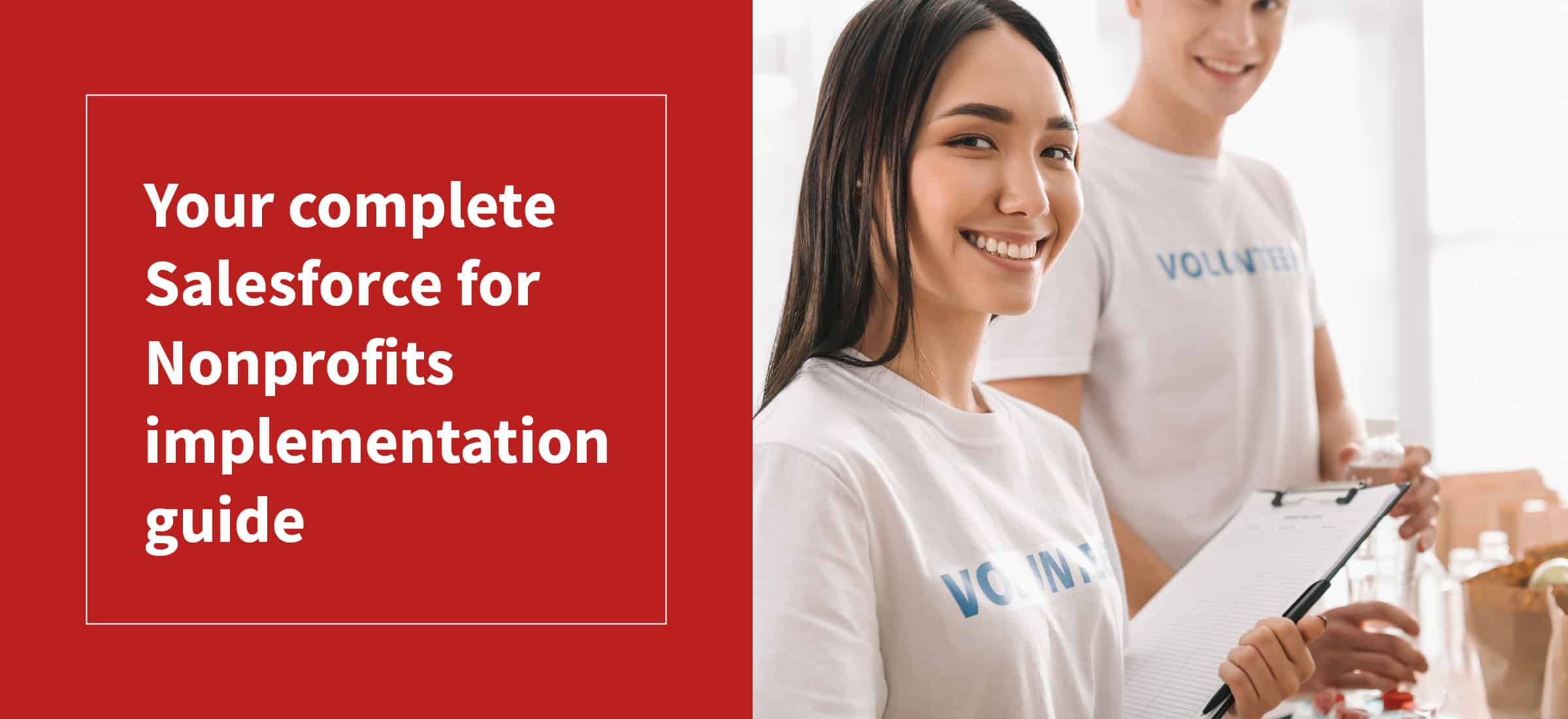
If your organization is considering investing in Salesforce for Nonprofits—or if you’re already committed to doing so—you’re on the right path. Salesforce is trusted by thousands of nonprofits because its platform offers solutions built with nonprofits’ needs in mind, is widely used and supported, and is highly customizable.
However, making the switch to a new system can be an involved process, and Salesforce for Nonprofits is no different. There are a lot of factors in play, from choosing the right solution for your organization to customizing the platform and migrating large amounts of important data. Many nonprofits find implementation overwhelming at first, so don’t worry if you’re not sure where to start.
In this guide, we’ll cover everything you need to know before diving into a Salesforce for Nonprofits implementation, including:
- Understanding Salesforce for Nonprofits
- Salesforce implementation partners
- Overview of the Salesforce for Nonprofits implementation process
- How to start your Salesforce for Nonprofits implementation
- Additional resources
As we explore each consideration and step in the process, try not to get too bogged down in the details. Implementing Salesforce for Nonprofits is an exciting endeavor that will expand your nonprofit’s data tracking, fundraising, and donor stewardship capabilities. Let’s dive into how to make it happen.
Understanding Salesforce for Nonprofits
Before getting started, it’s crucial to have a solid understanding of what exactly Salesforce for Nonprofits is and what your organization’s options are. Salesforce offers a wide range of packages, solutions, and add-ons, so we’ve broken down the key nonprofit offerings and considerations below.
What is Salesforce for Nonprofits?
Salesforce for Nonprofits is a collection of nonprofit-tailored solutions that help nonprofits use Salesforce CRM to drive impact.
The umbrella of Salesforce for Nonprofits includes products like the Nonprofit Success Pack (NPSP), Nonprofit Cloud, and a variety of other additions like Nonprofit Case Management and Marketing Cloud Engagement for Nonprofits. These solutions allow organizations to not only manage donor data but also analyze fundraising results, automate communications, and much more.
What’s the difference between NPSP and Nonprofit Cloud?
Until recently, NPSP has been the standard offering that anchored Salesforce for Nonprofits, and it still serves as the foundation of many other solutions. As of March 2023, however, Salesforce is now focused on its new Nonprofit Cloud—a reimagined version of the Salesforce CRM that combines features of other clouds with nonprofit priorities into a single, unified solution.
Both of these solutions are considered part of Salesforce for Nonprofits, but you’ll have to choose one to implement as the base Salesforce product for your organization. If you change your mind later, it is possible to migrate your data from one to the other, but you’d need to go through the implementation process all over again. Because of this, we recommend that you evaluate your options and make an informed decision ahead of time.
To help you understand your options, let’s break down the key differences between the two offerings:
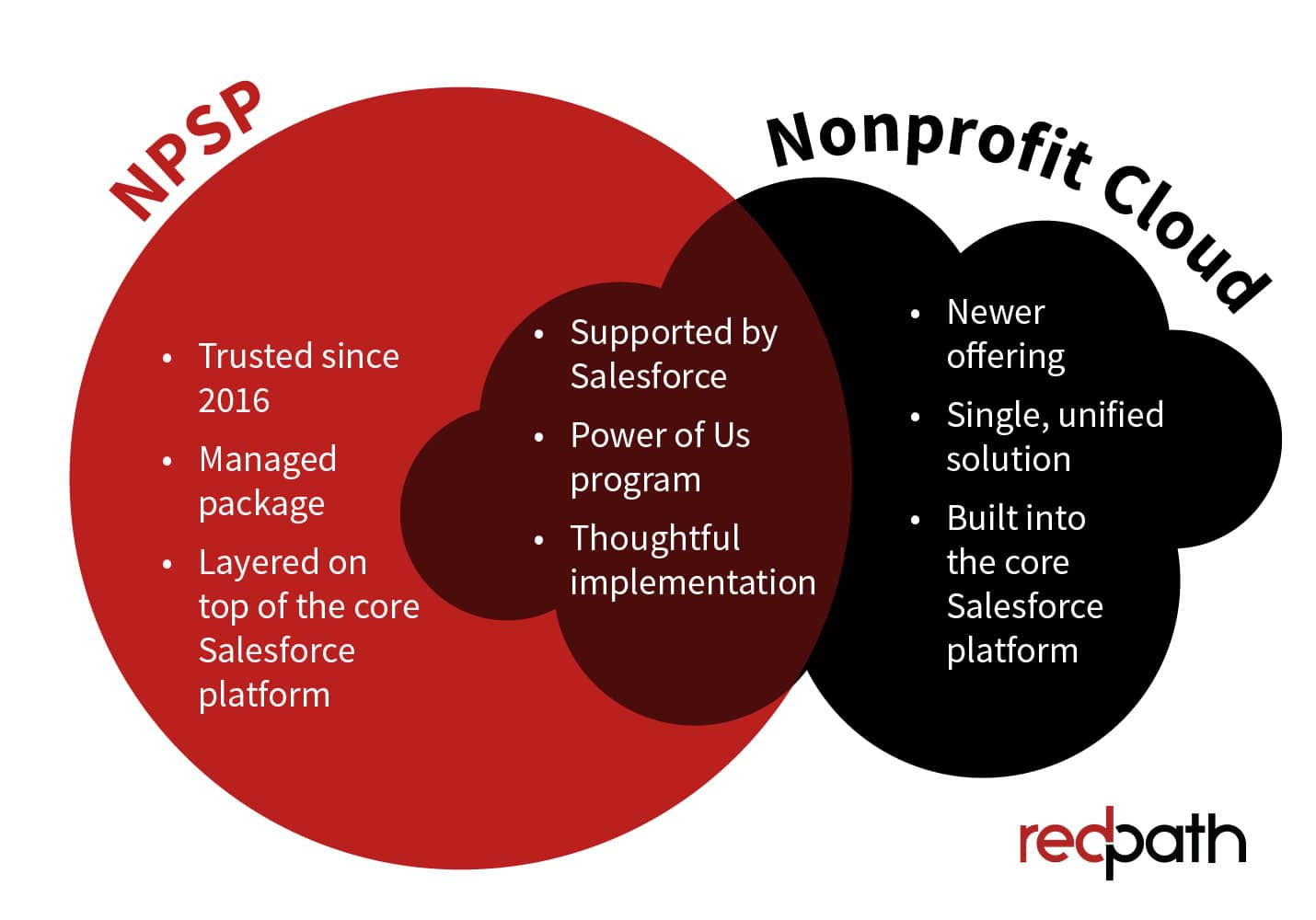
- Timeline: NPSP has been a trusted platform for nonprofits since 2016 and is currently used by thousands of organizations. Nonprofit Cloud is much newer, and some features are still in development. New fundraising and outcomes management features are expected to launch in the future.
- Type of product: NPSP is a managed package, meaning it’s a collection of apps installed on top of the Salesforce platform. Nonprofit Cloud is its own core product—a single, unified solution designed for nonprofits rather than a collection of apps.
- How they’re built: NPSP acts as a layer on top of the Salesforce platform, layering nonprofit apps on top of the base CRM. Nonprofit Cloud, on the other hand, is built directly into the core of Salesforce. It’s a base product that stands on its own and was built especially for nonprofits.
Despite the differences, some things remain true for both options. Currently, Salesforce actively supports both solutions (meaning that NPSP is not going away any time soon). Both NPSP and the new Nonprofit Cloud are also part of the Power of Us program, which gives eligible nonprofits 10 free licenses and additional discounts. Finally, no matter which option you choose, this implementation guide applies. Your nonprofit needs a thoughtful implementation plan to ensure setup runs smoothly and that you can make the most of your chosen solution.
Speak with a Salesforce implementation partner to evaluate your options and determine which offering would be a better fit for your organization.
What are the benefits of implementing Salesforce for Nonprofits?
Successfully going through the Salesforce for Nonprofits implementation process provides your organization with a variety of powerful benefits. At the end of the process, you’ll have an integrated platform that gives you a 360-view of your data, allowing you to improve fundraising, marketing, and donor stewardship with data-driven insights.
Here are some of the key features you’ll gain access to that can help you push your goals forward:
- CRM: In one unified system, you can track donations, donors, and engagement to help you efficiently manage all of your organization’s most important relationships, and it doesn’t stop there. Salesforce for Nonprofits also lets you track who benefits from your services, participates in your programs, and applies for grants. For example, if a constituent began as a mentee, became a volunteer mentor, and now works for a granting organization you receive funds from, you can track all of that engagement in one place.
- Salesforce apps: One of the features that makes Salesforce for Nonprofits stand out against other popular CRMs is the vast array of apps you can integrate into your CRM as add-ons. The Salesforce App Exchange offers additional tools for creating donation forms, performing prospect research, upgrading your marketing capabilities, and more.
- Custom reporting: Set the KPIs (key performance indicators) that are most important for your goals, then access custom reports on fundraising and program metrics. From here, you’ll gain actionable insights on how to improve your strategies and operations. Here’s a sample report from Salesforce’s training hub, Trailhead:
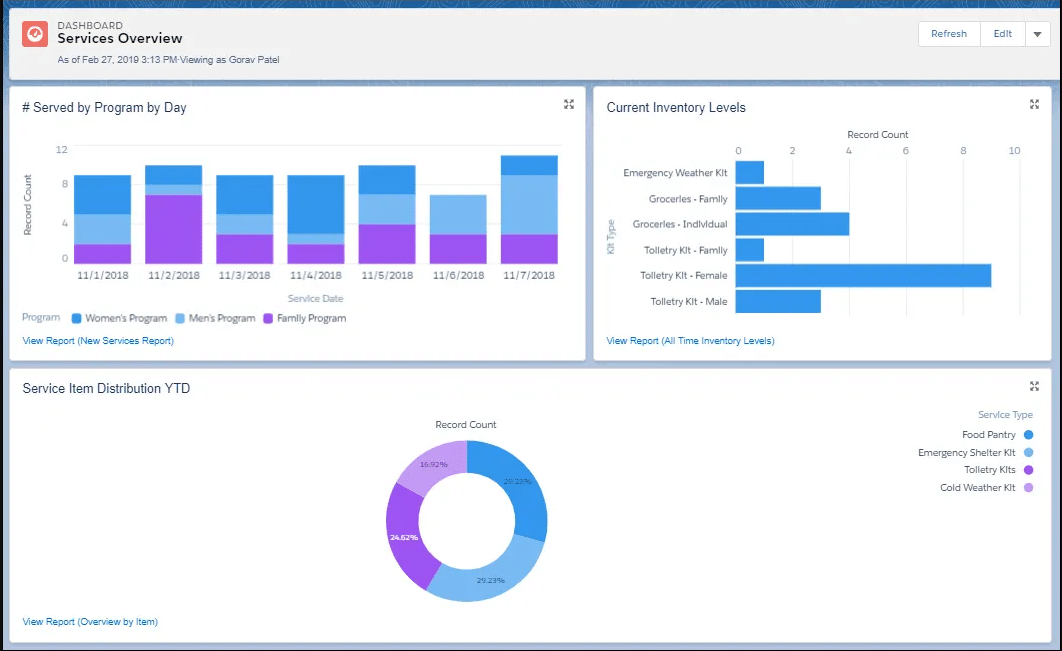
Source: Trailhead
These benefits are only the beginning. Explore Salesforce.org’s nonprofit pages to find more information on all the ways Salesforce for Nonprofits implementation can change the trajectory of your organization.
Is the Salesforce for Nonprofits implementation worth it?
Despite the wide-reaching benefits of Salesforce for Nonprofits, you may still be wondering if an implementation is worth the investment for your organization.
While you do get 10 free licenses, you need to consider additional implementation costs like data migration, customization and configuration, apps, training, and technical support. Discuss costs with your implementation partner to ensure you’re prepared to allocate enough of your budget and time commitment for the full investment before diving into your Salesforce implementation.
In the end, the ROI you see will depend on a variety of factors, including the size of your constituent base, the time and money you put into implementation, successful staff training, etc. However, when implemented and used strategically, Salesforce for Nonprofits can give you the tools to improve every facet of your nonprofit’s operations with data. Just take a look at the reasons 47,000 nonprofits use Salesforce for Nonprofits and consider the investment worthwhile.
Salesforce implementation partners
Now that you understand the basic offerings and considerations for a Salesforce for Nonprofit implementation, you’re ready to take the first step in the process by contacting an implementation partner.
Trying to implement Salesforce on your own is a major undertaking that can result in team frustration, data loss, technical issues, and ultimately a low ROI for your organization. Instead, work with an experienced Salesforce consultant that can lead you through every stage of the process to cultivate success.
Certified Salesforce implementation partners can help you with:
- Strategy: Salesforce consultants have seen it all and know which pitfalls to avoid in the implementation process. They’ll consider your experience and goals and advise you on the best strategies for your Salesforce for Nonprofits implementation.
- Configuration: Along with installing the base NPSP or Nonprofit Cloud, implementation partners can help you choose and configure the apps that help you push your organizational goals forward.
- Data migration: Migrating all of your donor data is a big undertaking that comes with plenty of risks. Salesforce partners know how to mitigate risks of data loss and ensure your migration goes as smoothly as possible.
- Staff training: Implementation partners’ work doesn’t stop once your new system is set up. They’ll provide resources to train your staff so that everyone on your team is prepared to hit the ground running with Salesforce.
- Ongoing Salesforce support: If you run into problems or confusion after implementing, your Salesforce partner can work through these problems with you on an ongoing basis.
It’s important to choose a Salesforce partner before you jump into the implementation process, as their input is pivotal at every stage. Research consultants by exploring their services, case studies, and nonprofit experience to find the best fit for your organization. You’ll be working with their team closely, so make sure you partner with a consultant you can trust.
Overview of the Salesforce for Nonprofits implementation process
After selecting and reaching out to your Salesforce partner, you can dive into the Salesforce for Nonprofits implementation process. Keep in mind that the process will be unique for each nonprofit depending on technical experience, needs, and goals. However, this overview of the general process will give you a good idea of what to expect.
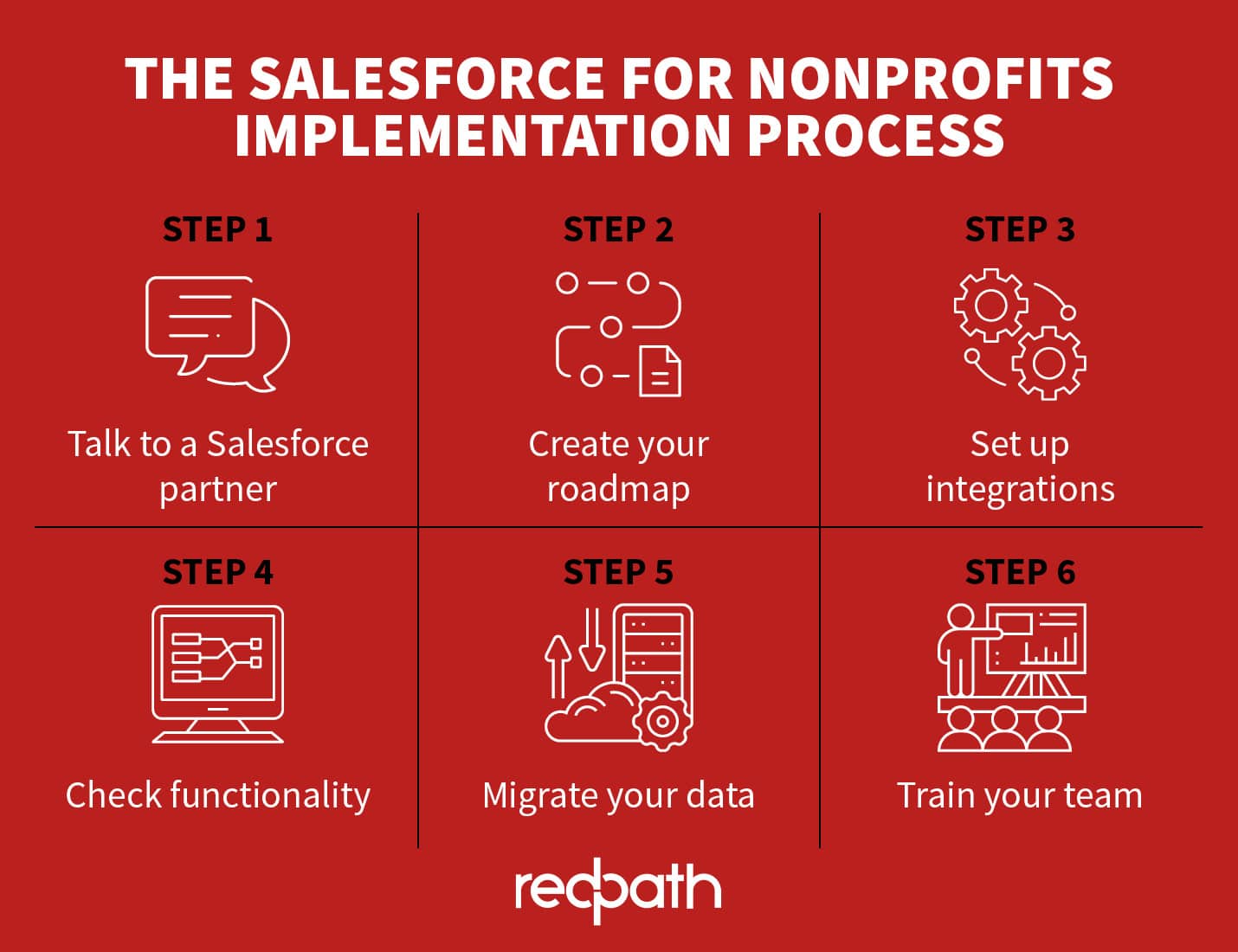
1. Discuss your goals with your Salesforce partner
The first step to implementing Salesforce for Nonprofits is to set up an initial consultation with your chosen implementation partner to discuss your needs and goals. In early meetings with your Salesforce partner, you’ll want to:
- Identify your vision for how you want to use Salesforce for Nonprofits.
- Evaluate your organization’s current data processes and pain points.
- Assess the benefits and drawbacks of NPSP and Nonprofit Cloud for your nonprofit.
- Determine KPIs for the implementation.
These determinations will likely not be accomplished in one meeting. It may take up to 6 weeks to thoroughly evaluate what you need from your implementation, and that’s okay. This is an important step in the process that you should take your time with to set you on the path to a successful implementation.
2. Create your Salesforce implementation roadmap
Based on your determined needs and goals, work with your implementation partner to create a detailed roadmap and timeline for the implementation. This plan should outline each step in your implementation process, how long steps will take, associated costs, and the roles of your nonprofit and your partner.
Qualified Salesforce partners will have their own established strategy for creating and moving forward with this initial roadmap. For example, Redpath Consulting Group follows a process called the Path to Success that takes a step-by-step approach to craft a thorough vision for your Salesforce for Nonprofits implementation that takes all of your priorities into account.
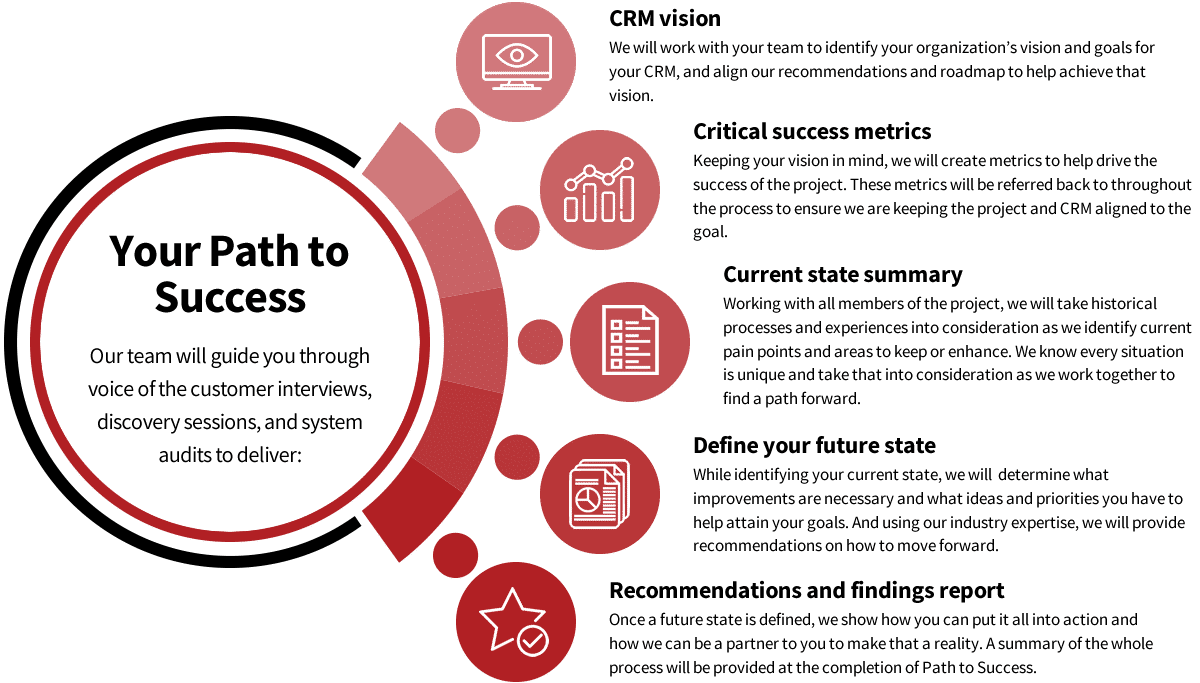
3. Platform configuration
Once you’ve established your roadmap, your implementation partner will start setting up your chosen platform for you. This step involves the setup of NPSP or Nonprofit Cloud plus any initial customizations and integrations you may need. Your Salesforce partner will configure your new apps, integrate Salesforce with any other tools you use, and customize the platform based on the goals you outlined earlier.
This stage of the implementation process is typically longer (multiple months) but will depend on the number of apps and integrations your organization needs to set up.
4. Test the functionality
Now the new system is set up, it’s time for your Salesforce partner to check its functionality. Your partner should work with you at this stage to ensure everything is working smoothly and implement fixes as needed. Normally, this involves multiple rounds of testing to verify that you won’t run into major issues down the line.
5. Migrate your data
Next, you’ll need to migrate your data from your old CRM to Salesforce. This will be a longer part of the implementation process because it’s so critical. Depending on the volume and state of your data migration, it could take anywhere from 1-6 months.
During this stage, your Salesforce consultant will create a detailed data migration plan to mitigate risks of data loss and start migrating your data. At Redpath, your implementation partner will be responsible for creating the plan, performing the migration, and checking the data afterward to verify its quality. Your nonprofit’s role in this process will be to identify the data you need to migrate and communicate with stakeholders to obtain any additional data.
If you choose another implementation partner, pay close attention in the buying process to make sure you understand your role and your implementation partner’s role in the data migration stage.
6. Train your team
Once setup, testing, and data migration are complete and your new Salesforce system is ready to go, the final step is to provide all relevant team members with the necessary training to be successful.
Your Salesforce implementation partner should work with you to determine the best approach for training based on factors like the scope of implementation and the skill sets of your team. You can also encourage your team to explore training resources on their own. Trailhead, Salesforce’s own training hub, is a good place to start.
How to start your Salesforce for Nonprofits implementation
Feeling more prepared to tackle your Salesforce for Nonprofits implementation now that you’ve seen how it works? Let’s go over what you need to do to get started:
- Once you have a clear understanding of all that implementation entails, evaluate if it would be a worthwhile endeavor for your nonprofit right now. Talk everything through with the necessary stakeholders at your organization and commit to a budget and decision.
- Then, research Salesforce implementation partners and evaluate your options. Pay special attention to each consultant’s experience with nonprofits, case studies, and ongoing services.
- Discuss your goals with your implementation partner to kickstart the Salesforce for Nonprofits implementation process. They’ll guide you through the rest of the process from there.
Remember, this is an extended endeavor that deserves your team’s time and attention. You get what you put into Salesforce for Nonprofits, so make sure everyone at your organization is aligned on putting in the work to make your implementation successful.
Additional resources
Salesforce for Nonprofits implementation involves plenty of considerations, plans, and moving parts, but you’re not alone. Salesforce consultants that specialize in working with nonprofits, like Redpath Consulting Group, are available and excited to help you through your entire implementation journey so you can focus on using the platform to further your mission.
Along with experienced implementation partners, there are a variety of additional resources available online to help you understand and begin the implementation process. Here are just a few resources to get you started:
- Salesforce is updating its Nonprofit Cloud: What does this mean? Need more information to choose the right solution for you? Read more about the new Nonprofit Cloud and how it compares to NPSP in this article.
- Why Salesforce for Nonprofits could be a better fit for your organization’s CRM than Raiser’s Edge. Learn more about the benefits of Salesforce for Nonprofits and all the ways it can help your organization thrive.
- 15 critical things to consider when migrating data from Raiser’s Edge to Salesforce for Nonprofits. Data migration is one of the most important parts of a successful implementation. Explore these key considerations for migrating your data.
With the rapid evolution of technology, Salesforce solutions are ever-changing and improving features. Contact our team for up-to-date information.




